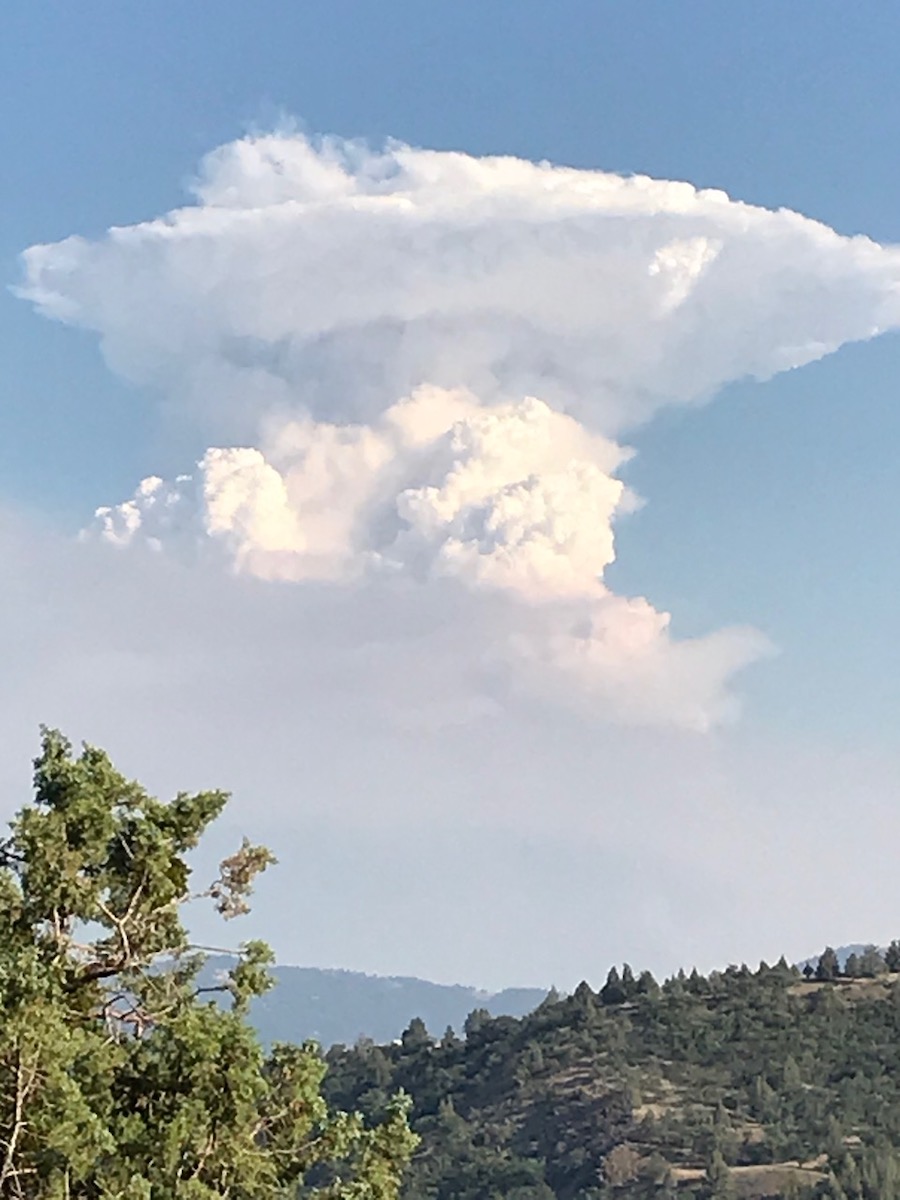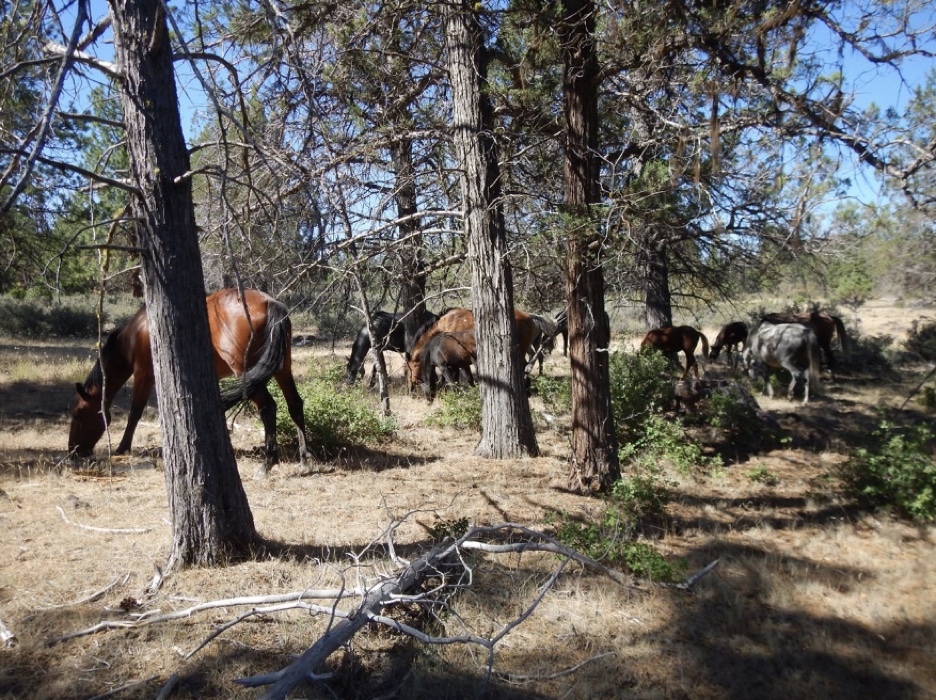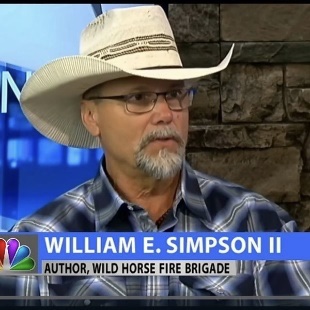Burning But Not Learning?

“According to ecologist-rancher Bill Simpson, animal impact, especially from wild horses, will better control wildfires and preserve fisheries than prescribed burns and dam removals. Here is an original point of view on a topic that needs fresh thinking.
NOTE: this article was originally written by Capt. William E. Simpson II – USMM Ret. Naturalist – Author – Conservationist – Wild Horse Ranch
Catastrophic Wildfires – Not The Klamath River Dams – Are Devastating Salmon Runs. Wild Horses offer an important partial solution to mitigating these wildfires.

A towering pyrocumulus cloud over Mt. Shasta during the Lava Fire. Photo: William E. Simpson II
The Mt. Shasta Fire, also known as the Lava Fire that melted some of the glacier and snow is resulting in the expected catastrophic erosion.
It seems that too many people, including elected officials and land managers, continue to overlook—or in some cases, intentionally ignore—a genuine cost-effective solution to catastrophic wildfire.
Why?
For a change, how about learning, instead of doing the same old things over and over expecting a new result?
Officials need to start listening to experience that is combined with un-politicized science or these fires will continue and grow increasingly worse. The result will be more and more socioeconomic devastation and the obliteration of our remaining forests and ecosystems.
All the while elected officials and land manager turn a blind eye, human suffering increases and post wildfire homeless camps grow, even as more of the remaining wildlife are being decimated, along with riparian areas and fisheries.
It is estimated that, depending on the ecosystem, between 20-80 animals per-acre are killed in wildfires. The mathematics of the wildlife devastation is horrific given that we have now experienced a “giga-fire” that scorched 1 million acres, resulting in at least 20 million animal deaths.
The impact of failed wildfire prevention is sending even more species of flora and fauna into the category of being endangered and threatened species, while some may even become extinct.
Clearly, current wildfire management programs are an overall FAIL!
Wildfires are growing more disastrous by the year!
Unless elected officials, politicians and land managers start listening to new ideas based on science and empirical experience, the entirety of western ecosystems may end-up being devoured by wildfires and many counties and towns will be virtually erased from the map…
Already, town after town, locally, regionally and nationally have been incinerated by wildfires fueled primarily by grass and brush.
Have we already forgotten the incineration of Phoenix and Talent, Oregon? What about Paradise, California and the 86 people killed as more than 200 homes were destroyed? The list goes on and on.
How many millions of acres of forests and the wildlife therein must we lose before intelligent land management is undertaken by reestablishing the native species herbivory?
How much catastrophic post-wildfire erosion must fisheries endure before we start doing what will work? When all the salmon are gone?
Many of the Indigenous peoples at the Klamath River’s mouth, including some so-called fisheries biologists, truly don’t even understand the problem that has affected our salmon and steelhead runs.
It’s definitely not the dams on the Klamath River that are causing shrinking salmon and fish runs.
The culprit in the loss of salmon is the catastrophic erosion that occurs post-wildfire and destroys fish eggs representing future salmon runs.
A Direct Correlation Between Loss of Salmon and Catastrophic Wildfire
The cause of the ongoing loss of returning salmon is directly related to and tied to the timing of the evolving catastrophic wildfires on America’s Pacific Coast.
When fewer fish eggs (and alevins) fail to survive after being covered with post-wildfire erosion sediment, fewer fish fry are produced and less fish return to the spawning grounds.
This simple factual phenomenon seems to be eluding many people, including some so-called fisheries biologists who are either willfully ignorant of basic principles or obfuscating this fact in favor of incentives that stem from dam removal projects, such as the Klamath River dams removal project.
Catastrophic wildfire differs from natural wildfire in the amount of heat generated by each. .
And the heat generated is a function of how much 1-hour class fuel (grass and brush) are involved. Science proves that when the natural herbivory, the native grazers such as deer, wild horses, and elk, are depleted or removed, grass and brush grow excessively. In other words, the absence of grazers means that the landscape is covered by abnormal amounts of potential fuel.
Catastrophic, abnormally hot wildfires destroy all the vegetation, including fire-evolved trees, on the landscape. These abnormally hot wildfires also pasteurize the soils, killing the microbiome and devastating the root systems that are critical in soil stabilization. This, in turn, results in catastrophic erosion when the fall and winter rains arrive and pelt the denuded slopes.
The damage to migratory fish runs is hiding in plain sight!
The culprit in failing salmon runs, along with changing ocean conditions, is the heavy post-wildfire silting-in of the spawning gravels in the river and stream beds aka redds. The fine silt accumulations suffocate the deposited fish eggs in the late fall and early winter. When the rains come, they wash topsoil off the lands that have been laid barren by the catastrophic wildfires during the summers.
It’s hard to help people—and county officials, land managers, congressmen— who won’t listen.
It’s been nearly five years since I first wrote to politicians and land managers about the situation. And numerous articles and press releases have been provided to help illuminate the solution.
Nevertheless, at unbelievably great cost in lives, property and natural resources, legislators and officials have empirically proven, they don’t have the right answers to this these serious issues. The problem is still growing!
Importantly, the climate is not a legitimate excuse; this is a fuel problem. Less fuel equals less fire.
And when presented with the facts and science that conflict with their failed approaches, pride and ego prevents some people from accepting the truth.
We can’t log our way out of this problem! Although, logging will not make matters worse.
One-hour class fuels, grass and brush (burn hotter than trees. CAL-FIRE’s fire forensic reports show that key fuels or kindling in most catastrophic wildfires is ‘grass and brush fuels’.
We cannot prescribe-burn our way out of this worsening situation; grass and brush return to the landscape in a matter of months after such burns, and the smoke from prescribed burns is harmful to human health and adds to greenhouse gas emissions.
Direct Correlation Between Loss of Herbivores and Evolution of Catastrophic Wildfire
Scientific studies, like the one from Dr. William J. Ripple, a professor of Forestry at Oregon State University, prove we need to reestablish our seriously depleted herbivory on the landscape. We can immediately implement positive changes that will jumpstart our depleted herbivory.
The first step is returning all the native species American wild horses that have been rounded up over the last 40 years back onto the landscape in wilderness areas designated as ‘critical wilderness’. It will take decades of hard work and sacrifice to reestablish the cervid (deer, elk, etc) populations in California and Oregon.
In the meantime, we have about 70,000 native wild horses that could be immediately deployed into wildfire fuels reduction roles. These wild horses have been rounded up and taxpayers are spending $100-million annually to keep them in off-range feed lots. It’s like putting the fire-department in jail during fire season.
If these wild horses are rewilded, the daily reduction of grass and brush, the primary wildfire fuels would be 1,100 tons daily. And the best part of this is that it’s cost free and there is virtually no risk compared to alternative and less effective methods for fuels reduction.

Photo: A family of wild horses symbiotically reducing wildfire fuels off a forest floor at no cost or risk to taxpayers. Photo from 5-year Study: ‘Impact of Wild Horses on Wilderness Landscape and Wildfire‘
The Science:
Collapse of the world’s largest herbivores: “By altering the quantity and distribution of fuel supplies, large herbivores can shape the frequency, intensity, and spatial distribution of fires across a landscape”. William J. Ripple1, Thomas M. Newsome1,2,Christopher Wolf1, Rodolfo Dirzo3, Kristoffer T. Everatt4, Mauro Galetti5, Matt W. Hayward4,6, Graham I. H. Kerley4, Taal Levi7, Peter A. Lindsey8,9, David W. Macdonald10, Yadvinder Malhi11, Luke E. Painter7, Christopher J. Sandom10, John Terborgh12 and Blaire Van Valkenburgh13 http://advances.sciencemag.org/content/1/4/e1400103.full
Rewilding: Jozef Keulartz. “The removal of large herbivores has adverse effects on landscape structure and ecosystem functioning. In wetter ecosystems, the loss of large herbivores is associated with an increased abundance of woody plants and the development of a closed-canopy vegetation. In drier ecosystems, reductions of large grazers can lead to a high grass biomass, and thus, to an increase in the frequency and intensity of wildfires. Together, with the loss of a prey base for large carnivores, these changes in vegetation structures and fire regimes may trigger cascades of extinctions (Bakker et al., 2016; Estes et al., 2011; Hopcraft, Olff, & Sinclair, 2009; Malhi et al., 2016).” http://oxfordre.com/environmentalscience/view/10.1093/acrefore/9780199389414.001.0001/acrefore-9780199389414-e-545
Each horse deployed into a wildfire fuels reduction role consumes about 5.5 tons of grass and brush per year. At the same time, they reseed the native plants which control erosion. All of that is by a natural plan that evolved over millions of years.
Instead of spending $100 million/year in tax dollars to roundup, house and feed wild horses held captive, we save the $100 million/year by deploying these wild horses into wildfire fuels reduction roles in designated “critical wilderness areas,” which must be protected from catastrophic wildfire at all costs.
In this wildfire fuels reduction role, those 70,000 wild horses will symbiotically mitigate wildfire fuels at the rate of approximately 400,000 tons of grass and brush annually. They also sequester the carbon compounds back into the soil instead of sending them into the atmosphere as greenhouse gases via wildfire smoke.
More about the wildfire reduction plan ‘Wild Horse Fire Brigade’ at: www.WHFB.us
William E. Simpson II is a naturalist/rancher living among and studying native species American wild horses. He is the author of two published books and more than 100 published articles on subjects related to wild horses, wildlife, wildfire, and public land (forest) management. He has appeared on NBC NEWS, ABC NEWS, theDoveTV and has been a guest on numerous talk radio shows including the Lars Larson Show, the Bill Meyer Show, and on NPR Jefferson Public Radio.

